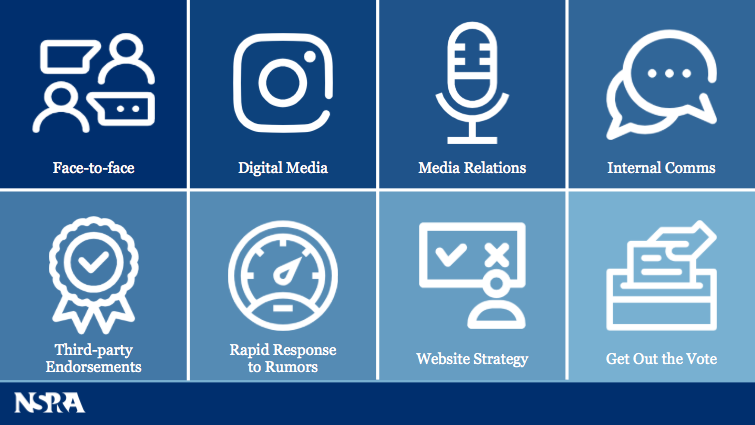#SchoolPR in an Evolving World
The leader in school PR, the National School Public Relations Association hosts an annual gathering of school communications professionals and school leaders each year. The seminar went online this year — NSPRA Live2020, and once again provided outstanding professional development for members.
With more than a dozen live sessions and 30+ on-demanded sessions to view, educators and communicators flocked into the virtual chat rooms. Participants learned about how to create successful referenda campaigns, the important work of equity and inclusion, how communication evolves during a pandemic, and more. Throughout all of the sessions, there was one overarching theme: how strategic communications engage the public and your stakeholders in conversations about our public schools.
At CEL, we were incredibly honored to present one live presentation about referenda and community engagement and another on-demand presentation featuring our award-winning Richfield Public Schools rebranding journey.
SUCCESSFUL REFERENDUMS
“You have to have a plan that is acceptable for the community it can’t just be the superintendent’s pipedream.”
Our Vice President Janet Swiecichowski, APR presented a live session, “Millions at Stake: A Guide to Referendum Success.” With co-presenter Annette Eyman, APR, the two shared research, and Top Ten Tips from NSPRA Gold Medallion referenda campaigns. The primary focus was on the importance of engaging the public in conversations from the beginning. It’s about asking questions and listening with the intent to find consensus.
“Love me suddenly doesn’t work!” – Brian Woodland, APR
Janet reminded us, “The public owns our public schools. So, the public needs enough information to make informed decisions about the schools.” It takes time, outreach and transparency to build relationships with community members prior to a referendum. When looking for support, start by listening. Concentrate your energy and time on building a relationship with your public. You want to get an accurate sense of what they value and hope for their kids and their schools.
“Communities make decisions for their schools.”
A successful referendum campaign follows the 4-step process:
- Research
- Planning
- Implementation
- Evaluation
Once you have conducted your research, set goals, define targeted audiences and set specific objectives by audience. Think broadly about strategies. Begin with your messaging strategy. Give people a reason to vote for the initiative; create a compelling narrative focused on children, the future and learning. Your research should have revealed your community’s hopes and dreams for its children. Align your narrative accordingly.
Leverage all your existing strategic communication channels in support of the campaign.

EQUITY AND INCLUSION
Naomi Sigler Hunter, APR; Stephen Nichols, APR and Donna Elam, Ed.D. presented a session on “Data, Disruption and Demographics: How School Ratings are Contributing to Racial Isolation in Our Schools.” The presenters dove deep into how school ratings and choice perpetuate racial and economic segregation.
Rating sites like GreatSchools.org partner with real estate firms—firms whose primary goal is to sell more expensive houses, and they use rating sites that drive customers away from largely diverse neighborhoods. The result: our schools are more segregated today than they were in the 1970s. Most parents want their children to be prepared for a diverse and changing world, but using existing rating sites will only serve to more racially isolate students, as documented in this Harvard School of Education report.
Diversity, equity and inclusion begin with your brand. How do your stakeholders describe your brand? Is it welcoming and inclusive?
CEL was honored to work with the Richfield Public Schools through a community engagement process to redefine its brand. The Richfield team listened intently and put energy into relationships with students, alumni and other community members. Now, they have a brand and a logo that communicates a more unified, welcoming community for all students and staff. Richfield Public Schools Superintendent Steven Unowsky discusses just how impactful brands and logos can be on students and how important open communication with your stakeholders is for a school’s culture.
COMMUNICATING THROUGH A PANDEMIC
School communicators have never been busier! Communicating and engaging stakeholders is especially important during the pandemic. A few key take-aways from this year’s presentations:
- Frequency: People need to hear from school leaders often, even if you do not have new information. Regular updates communicate that you are continuously working on a complex situation.
- Focus on three messages: Safety. Social-emotional health. Relationships and quality learning. Learning is about meeting every child where they are at and keeping them engaged. This school year will be different and learning still matters.
- Equity drives decisions: COVID-19 has revealed disparities that exist in our society. How are we reaching all families and meeting the needs of all students? Access for all needs to be a priority for every district.
Published on: July 16, 2020